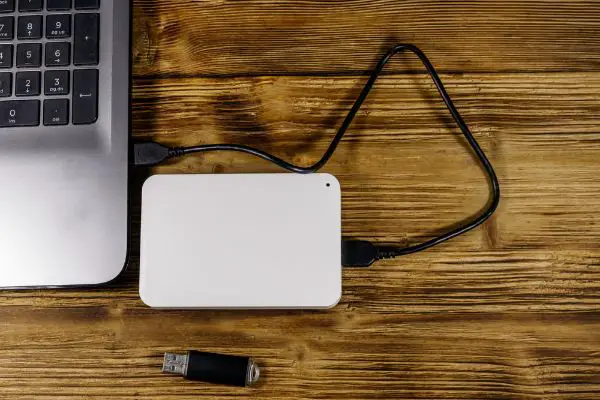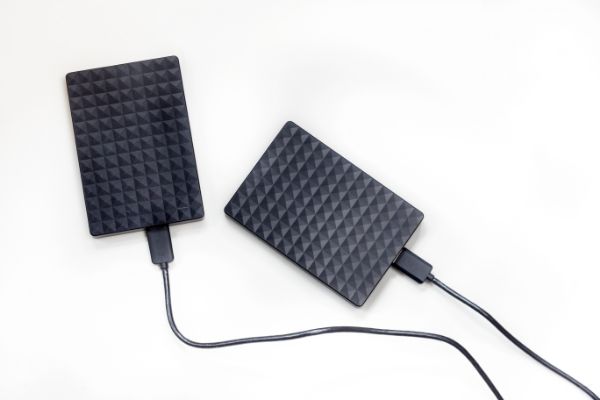Disclaimer: This post may contain affiliate links, meaning we get a small commission if you make a purchase through our links, at no cost to you. For more information, please visit our Disclaimer Page.
The hard drive is one of the most important components in your computer’s setup. You can think of it as the memory part of the computer’s brain, and it is where it stores all the necessary data for the operating system or files that you download to it.
Often abbreviated as simply “HDD”, many hard drives are mechanical in nature. They need to spin on a platter while they are working in order to write data.
Sometimes, the spinning might be loud or aggressive enough for you to hear it when the computer is running. Some users might note that their hard drives are spinning and seem to be functioning normally, yet they are not detected by the system.
We’ll go through some possibilities as to why this might be, some of the fixes you can try, and other scenarios in which the drive itself may or may not spin.
Table of Contents
Why Can I Hear External Hard Drive Spinning but It’s Not Detected?
While a native hard drive can sometimes spin loudly enough for you to hear it, this is even more true when it comes to external hard drives.
Usually, you’ll connect external hard drives by plugging them directly into a computer’s USB port. This method allows the laptop or PC to recognize the presence of the new device almost instantly, thus giving you quick access to a whole new place to store gigabytes of data or access files you already have on the drive.
The reason you might hear the external hard drive spinning is that, while it does have a case surrounding it, it is not seated inside a standard computer tower case that might absorb some of the sound.
Regardless, a spinning hard drive is usually a good thing, and it is one of the markers that tells you the unit is thinking.
However, there are times in which you might be able to hear the continuous spinning of the drive but still receive no notification on the computer that a new device is present in the system.
There are a few probable reasons why this might be so, and we will look at some of the most common ones.
1. It is possible that there are no partitions defined within the drive itself. This means that the entirety of the drive is something that the computer looks at as totally unallocated space. This is common with brand new hard drives that are fresh out of the box, but it can happen to used or older hard drives as well.
2. If partitions are present, there might be no letter associated with particular partitions. You’ll notice that the main drive of your computer is probably called the ”C” drive. Any other drives that you connect to your desktop or laptop also need lettered partitions in order to be recognized and usable in the system.
3. Your drive isn’t formatted as either of the two common FAT32 or NTFS systems that most computers recognize. It could instead show up as something called RAW, and we will get to what that means and how to address it in the next section.
4. There could be loose physical connections that are causing problems with the links between the drive and the computer.
5. The drivers that you might need in order for the external hardware to get access to and recognition from the system may be outdated or not present at all.
How Do I Fix This?
As you can see, there are a few probable causes as to why the external hard drive spins like it is functioning but fails to link up with the computer properly. We’ll go through each problem listed above and offer one of the most likely solutions that could work.
Our list is not comprehensive, and you could be dealing with a drive that is simply bad, but we will work on the presumption that this is an issue you can fix with a little troubleshooting.
1. For unallocated space, you will need to repair it in order to restore the hard drive to good working order. If you had data on the drive already that you can no longer see, it isn’t necessarily gone, but the unallocated space prevents it from being seen or accessed by the system.
One thing you can try is to use one of the many data recovery software programs that are available online.
They can scan the unallocated space and look for the lost data in the partition that no longer shows up.
Once you’ve recovered the things that you want, you can then delete the unusable partition and create a new one where you can place the recovered data using ‘Disk Management’.
2. If there is no letter associated with a partition you can see, that’s an easy fix. All you need to do is use the right mouse button and click on the partition.
From there, you can choose to assign a letter name to the partition. Once you do this, back out of everything and reboot your operating system to allow it to update the registry.
3. If the file system seems to show up as ‘RAW’ rather than one of the other two traditional systems for HDDs, it means that there is some data in the structure of the drive.
However, the operating system is having problems recognizing that data, or it is corrupt. If this is a drive you have used regularly, you may be able to use recovery software to get the data off the drive and check for corrupted files. You will need to reformat the drive after this.
4. Check the physical connections between the computer’s USB ports and the cables and your drive. There may be some loose or malfunctioning connectors that prevent the two devices from talking to each other.
5. Finally, you can try updating the device drivers in your system to see if that helps the computer recognize the drive.
Is It Normal To Hear an HDD Spinning?
Thanks to good fans and nearly constant improvements to hardware, most modern computers run very quietly, especially compared to their larger, older cousins. With that in mind, some people may wonder if hearing a hard drive spinning is normal.
Mostly, it is perfectly normal to hear some noise from the hard drive. The hard drive almost always needs to access data when you are using the computer, and it will also want to write data when you are modifying or saving files to it. To do these tasks, your drive will spin as it works.
The spinning should not be excessively fast or loud. If you do notice the noise of a spinning drive that seems to be very loud, it could indicate some kind of potential failure or problem with the drive.
However, the drive could also be working hard writing or retrieving data for you. If it is just temporary, even a loud drive isn’t necessarily a problem.
Do Hard Drives Spin When Not in Use?
This is a complex question to answer, as it relies on a set definition for how we might define “in use” in terms of when the system is using the drive.
In most cases, a hard drive shouldn’t spin when it is not in use at all. However, any time you are on the computer and doing tasks, the operating system will want to have regular access to the hard drive.
This means that it may spin up and down even if you are not regularly accessing files or saving things. In short, the hard drive is in use at various intervals as long as the computer is switched on and active.
Does the Hard Drive Still Spin in Sleep Mode?
Under normal circumstances, your hard drive should not spin in sleep mode. Any sleep or hibernation modes on a computer shut down many of the components or processes to prevent overuse or damage.
It is possible that your internal or external drives might still spin for a few minutes after the computer enters sleep mode, but they should quiet down and stop after a short time.
You may need to run a few checks if you find that the drive continues to spin long after you have activated sleep mode. Such a thing could show that there is some kind of failure going on with the drive, or it might mean that the device had a fault in its design from the start.
Either way, you can get to the bottom of it to figure out what to do. If you use the drive for backups, it is a good idea to unplug it from the computer when it is not in use.
How Do I Stop My Hard Drive From Spinning When Not in Use?
This is mostly an issue with external hard drives. Internal hard drives should have settings to spin down automatically after they have been inactive for a while.
Once the computer is powered down, there is no reason for the internal HDD to keep spinning. However, you may notice that an external drive will keep spinning even when you put your computer into any kind of low-powered state.
If this is happening, check which USB port your drive connects to, and consider disconnecting it entirely. Usually, at least one of the USB ports on a computer still supplies power when the PC is turned off. Not all computers support this, but those that do might label said ports.
Why Is External Hard Drive Not Detected and Beeping or Flashing?
If your hard drive is not detected and is making beeping or flashing noises, this could indicate a problem with the hard drive itself or its connection to the computer. Here are a few possible causes:
1. Connection Issues
Your hard drive may not be properly connected to the computer or may be connected to a faulty USB port. To fix this, try disconnecting and reconnecting your external hard drive to a different USB port.
The USB cable connecting the hard drive to the computer may also be the issue. Try using a different USB cable to see if that resolves things.
2. Power Issues
Your Hard drive may not be receiving enough power from the PC or the power supply may be damaged
3. External Damage
Does your hard drive been dropped before? If so it may not be working correctly. Exposing it to intense weather can also damage it.
5. Mechanical Failure
There may be an issue with the hardware in the hard drive such as a damaged circuit or failed motor that prevents it from functioning correctly, causing it to flash or beep.
4. Other issues
There may be issues causing this problem such as:
- Virus/Malware
- Partition Issue
- File system problem
In conclusion, if you find your hard drive not being detected and making beeping noises or flashing, it is important to identify the cause of this.
Conclusion
The hard drive is where all of your important data is stored, so it makes sense to know how to care for it. Additionally, it is good to know some of the common signs of a drive that may be under stress, failing, not formatted properly, or other concerns that can cause it to be unrecognizable by the system itself.


